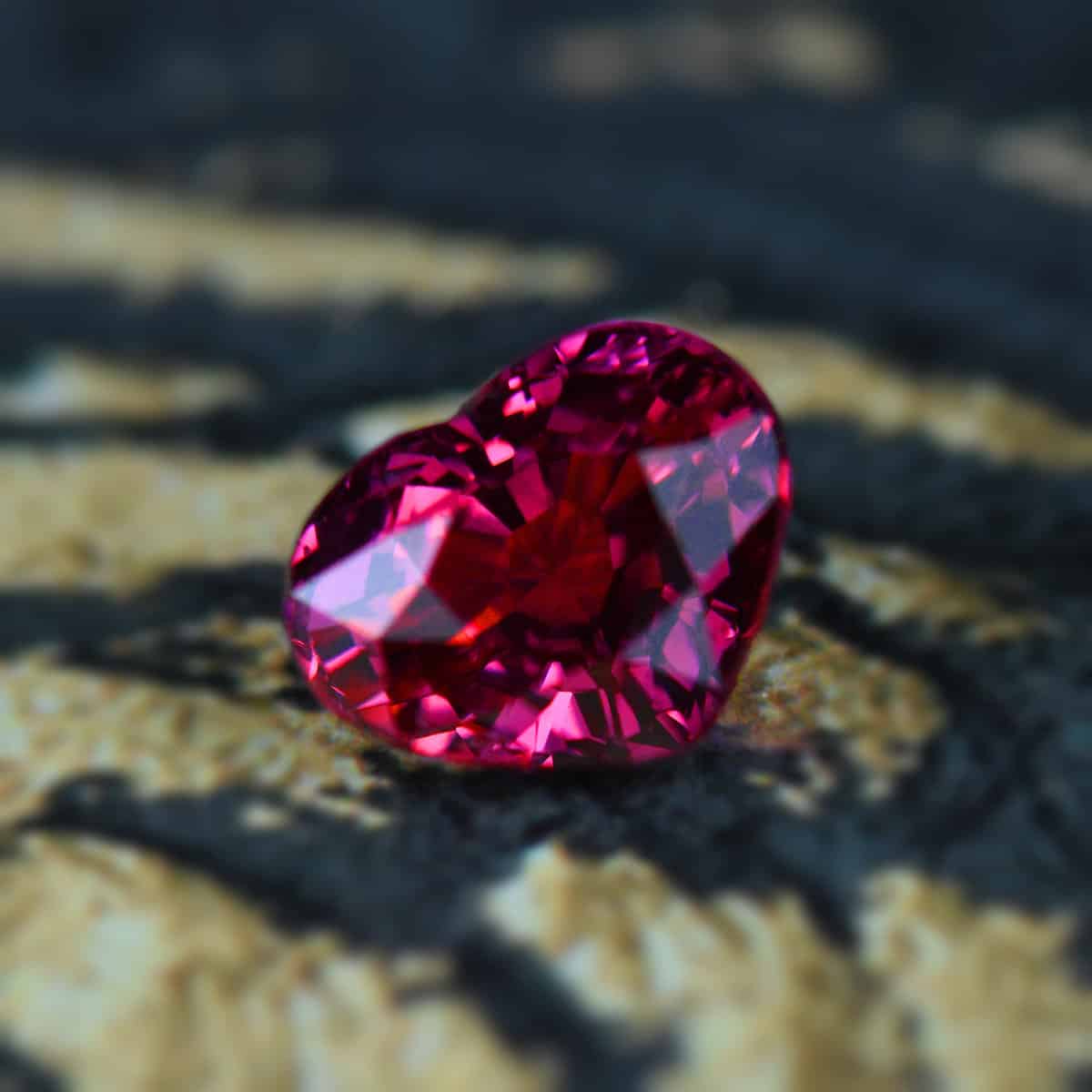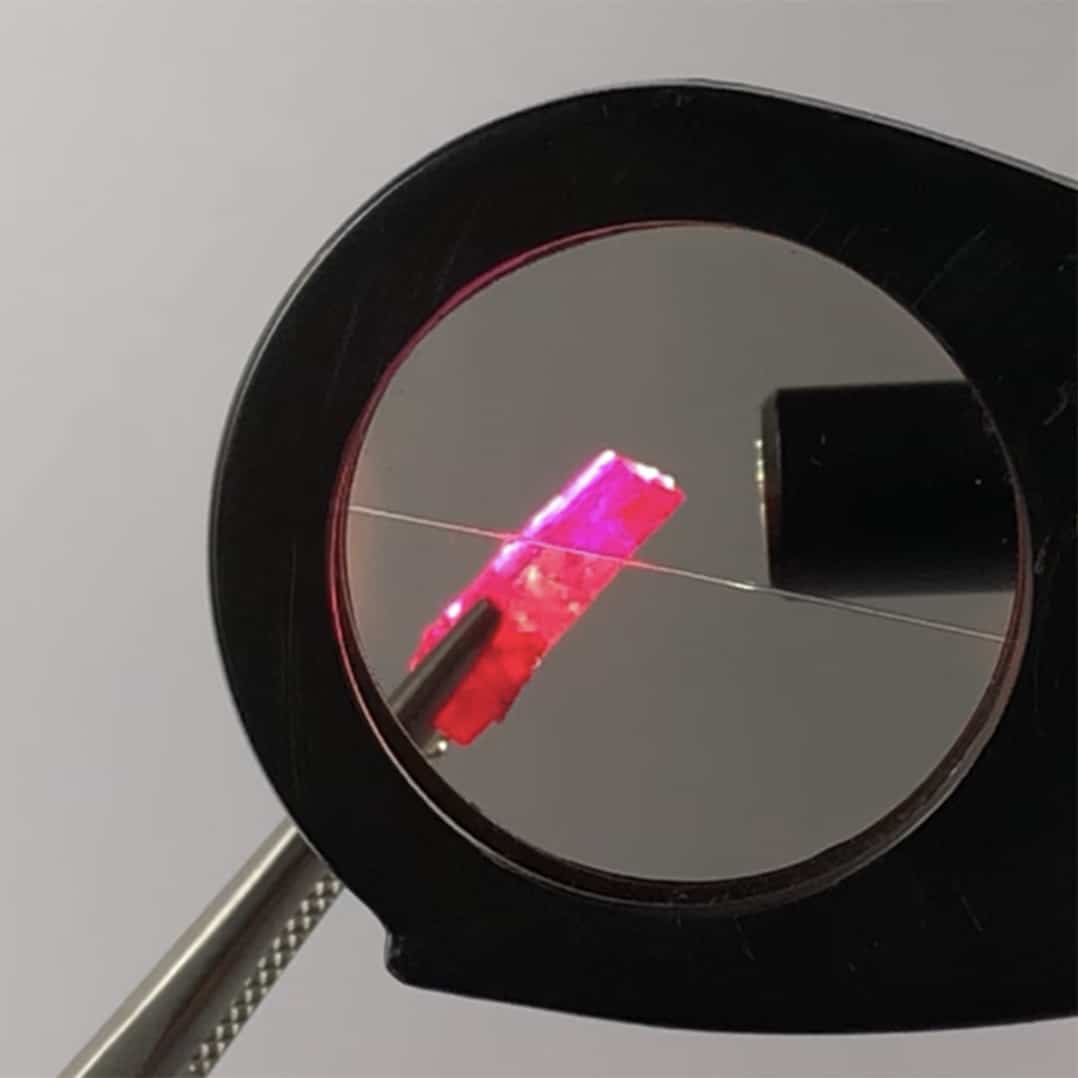
Is it possible to tell the difference between red spinel and ruby with the naked eye?
Yes, it is. However, the similarities between Red Spinel and Ruby are striking, and it can be very difficult to people who are not trained and experienced gemologists, to distinguish between the two with the naked eye.
Because of this, red spinel has often been used to imitate ruby. In fact, the similarities are so convincing, that up until the late 19th century there was no distinction at all between the two gem types. Many famous old “Rubies” were in more modern-times discovered to be Red Spinel. The most famous example of this confusion is the massive “Black Prince’s Ruby”, the centerpiece of the royal crown of England, which is actually a spinel. In the picture below we can see in the top half of the lens the light-ray look reddish-purple-pink. However in the bottom half, the light-ray looks orangish-red.
How to Differentiate Between Red Spinel & Ruby
Although extremely similar to the naked eye, the fundamental differences between ruby and spinel are profound.
Ruby is a doubly refractive material, meaning that light is split into two rays as they pass through the body of the ruby, and each separate ray has a different color hue. With the aid of a dichroscope, a device that utilizes juxtaposed polarized lenses, we can see the two different colored rays in ruby quite easily.

Spinel however, is a singly refractive material, and cannot ever exhibit this “pleochroism”, or “many colors”. When light passeses through spinel it stays in a single ray and can only exhibit one color.
In the real world, away from gemological theory and professional instruments, how do you tell the difference with household items? The answer is pretty easy. Polarized sunglass or a computer monitor can help.
Double Refraction for Ruby, Single for Spinel
Given the fact that both ruby and spinel tend to not to huge gemstones, the vital clues of optical doubling tend to be missed. However, with the aid of a jewelers loupe, the magnifying glass beloved of jewelers, diamantaires and gemologists, we can look for the signs of optical doubling, or, double refraction.
Double refraction in gemstones tends to present itself as a “doubling” of an image. This is generally easiest seen against the straight angular lines of the facet meets.

The rather confusing “drunken” look of this picture is due to the microscope seeing double. Look carefully and you can see each facet actually has two images, which creates this blurry seeing-double look. The crystallographic properties of ruby create this doubling and it should be noted that spinel can never exhibit this effect.
*It is also worth noting that this effect is less pronounced on small rubies and is mostly easily seen under high powered magnification. It is often visible with 20x loupe, but please remember to tilt the ruby off the c-axis orientation through which the doubling cannot be seen.
Carmine & Cornflower – The Transmission Twins
Like all materials, ruby and spinel absorb light. Light that is not absorbed, is transmitted. The resulting transmission and absorption spectra are unique fingerprints and are specific to each gem.
By carefully angling a red pink spinel when can get the gem to act like a prism and cast light into visible-spectrum. The array of color seen cannot include green in a ruby, but can in a spinel. Below we look at spectral array of Mahenge spinel.
We can see that both yellow & green are visible in the spectrum of Red-Pink Mahenge Spinel. However red, blue, and purple hues (wavelengths) with very little yellow, and absolutely no green at all.
Referring back to the optical doubling again, the twin images that can be seen in ruby, becomes twinned due to doubly refractive nature of ruby.
Ruby & Spinel Observational Differences
Ruby & Spinel Differences
| wdt_ID | Observations | Ruby | Spinel |
|---|---|---|---|
| 1 | Flourescence | Very Variable. | Sometimes Pronounced in Burmese and Mahenge Spinel to the naked eye. |
| 2 | Heft & Weight | Feels Heavier | Feel A Little Lighter |
| 3 | Brightness | Technically is brighter material than spinel. | Latently is slightly duller, however as it is slightly softer it is easier to polish and is frequently seen with a tremendous polish. |
| 4 | Size | Slightly smaller due to denser mass. | Slightly bigger due to lighter mass. |
| 5 | Directional Color | Yes. Shows Red, Reddish Orange and Reddish Purple in each of the three different directions. Please note this is visible on cleaner and larger rubies only. | No. Shows single color in all the 3 directions. |
| 6 | Temperature | Feels colder on the lips | Feels slightly warmer. |
| 7 | Image Twinning | Shows image twinning in red and blue. | Shows no image-twining due to being single-refractive. |
| 8 | Facet Meets | Harder. More likely to have and to keep atomically sharp facet-meets. | Softer and is more prone the 'nibbling' of facet meets. |
Leave a reply